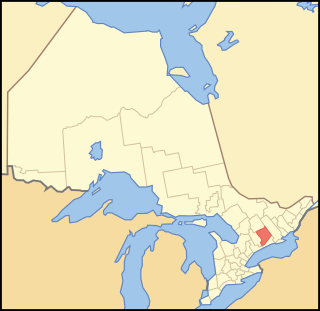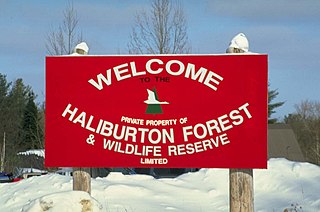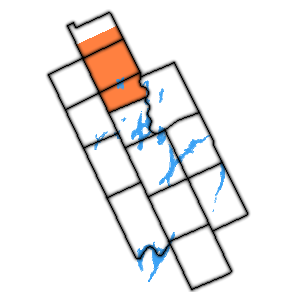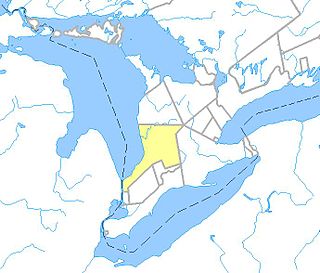Related Research Articles

The Province of Upper Canada was a part of British Canada established in 1791 by the Kingdom of Great Britain, to govern the central third of the lands in British North America, formerly part of the Province of Quebec since 1763. Upper Canada included all of modern-day Southern Ontario and all those areas of Northern Ontario in the Pays d'en Haut which had formed part of New France, essentially the watersheds of the Ottawa River or Lakes Huron and Superior, excluding any lands within the watershed of Hudson Bay. The "upper" prefix in the name reflects its geographic position along the Great Lakes, mostly above the headwaters of the Saint Lawrence River, contrasted with Lower Canada to the northeast.

The County of Victoria, or Victoria County, was a county in the Canadian province of Ontario. It was formed in 1854 as The United Counties of Peterborough and Victoria, and separated from Peterborough in 1863. In 2001, the county was dissolved and reformed as the city of Kawartha Lakes. Though first opened to settlement in 1821, the area that was encompassed by Victoria County has a history of Indian occupation, first by the Hurons.

Peterborough County is located in Southern Ontario, Canada. The county seat is Peterborough, which is independent of the county.

The City of Kawartha Lakes is a unitary municipality in Central Ontario, Canada. It is a municipality legally structured as a single-tier city; however, Kawartha Lakes is the size of a typical Ontario county and is mostly rural. It is the second largest single-tier municipality in Ontario by land area.

Haliburton is a county of Ontario, Canada, known as a tourist and cottage area in Central Ontario for its scenery and for its resident artists. Minden Hills is the county seat. Haliburton County and the village of Haliburton are named after Thomas Chandler Haliburton, author, statesman, and the first chairman of the Canadian Land and Emigration Company.

The District Municipality of Muskoka, more generally referred to as the District of Muskoka or Muskoka, is a regional municipality in Central Ontario, Canada. Muskoka extends from Georgian Bay in the west, to the northern tip of Lake Couchiching in the south, to the western border of Algonquin Provincial Park in the east. A two-hour drive north of Toronto, Muskoka spans 6,475 km2 (2,500 sq mi). Muskoka has some 1,600 lakes, making it a popular cottaging destination.
Anthony Van Egmond was purportedly a Dutch Napoleonic War veteran. He became one of the first settlers and business people in the Huron Tract in present-day southwestern Ontario Canada. Van Egmond became an early contractor employed by the Canada Company to construct the original 74-kilometre (46 mi) road into the new settlement, allowing the entry of settlers for the purchase of company lands and further economic development. He eventually became a supporter of William Lyon Mackenzie and led a force of armed rebels in their unsuccessful skirmish at Montgomery's Tavern near Toronto on 7 December 1837, during the Upper Canada Rebellion.

Ramara is a lower-tier township municipality in Simcoe County, Ontario, Canada.

Haliburton Forest & Wild Life Reserve Ltd. is a privately owned 300-square-kilometre (120 sq mi) forest in Haliburton County, Ontario. Abutting Algonquin Provincial Park, Haliburton Forest is a "multi-use forest", with the Haliburton Forest Wolf Centre, a canopy walk, and a freshwater tour submarine as popular points of interest. Haliburton Forest forestry operations were certified by the international Forest Stewardship Council in Canada. Haliburton Forest supports ecosystem-based research projects, primarily conducted by the University of Toronto's Faculty of Forestry, and operates year-round recreation, tourism and education programs.
Ontario County was the name of two historic counties in the Canadian province of Ontario.
Halton County is a former county in the Canadian province of Ontario, with an area of 228,181 acres (923.42 km2). It is also one of the oldest counties in Canada.

Kennisis Lake is the 2nd largest lake in the Haliburton Highlands with a surface area of over 1,640 hectares in the area of Ontario just south west of Algonquin Provincial Park. From end to end, the lake is approximately 23 kilometres (14 mi) long. There is a smaller counterpart, named Little Kennisis Lake.

The United Townships of Dysart, Dudley, Harcourt, Guilford, Harburn, Bruton, Havelock, Eyre and Clyde, commonly known as the Municipality of Dysart et al, is a municipality in Haliburton County in Central Ontario, Canada. The original townships were of the Canadian Land and Emigration Company.

The united Townships of Laxton, Digby and Longford were a municipality in the northern part of what is now Kawartha Lakes in the Canadian province of Ontario.

The Township of Verulam was a rural municipality within the former Victoria County, now the city of Kawartha Lakes. It was bounded on the north by the geographic township of Somerville, the south by the geographic township of Emily, the west by the geographic township of Fenelon, and the east by the County of Peterborough. For the purposes of government, land surveying and reference, it is now properly referred to as the "Geographic Township of Verulam".

South-West Oxford is a township in the Canadian province of Ontario, located within Oxford County. The township had a population of 7,664 in the 2016 Canadian census. A predominantly rural municipality, South-West Oxford was formed in 1975 through the amalgamation of Dereham and West Oxford townships and the village of Beachville.
Mossom Boyd was an Anglo-Irish entrepreneur who developed and operated a large lumber business on the Trent river system in Ontario, Canada.

The Gull River is a river in Algonquin Highlands and Dysart et al, Haliburton County and the single-tier municipality of Kawartha Lakes in south-central Ontario, Canada. It is in the Trent River and Lake Ontario drainage basins, and flows from southern Algonquin Provincial Park to Balsam Lake on the Trent–Severn Waterway.

The Huron Tract Purchase also known as the Huron Block, registered as Crown Treaty Number 29, is a large area of land in southwestern Ontario bordering on Lake Huron to the west and Lake Erie to the east. The area spans the counties of Huron, Perth, Middlesex and present day Lambton County, Ontario in the province of Ontario.
The Queen's Bush was an area of what is now Southwestern, Ontario, between Waterloo County, Ontario and Lake Huron that was set aside as clergy reserves by the colonial government. It is known as the location of communities established by Black settlers, many formerly enslaved in the United States, in what would become Canada. Established in 1820 and known as the Queen's Bush Settlement, the community grew to more than 2,000. In the early 1840s, the land on which they lived was surveyed for future sale. Following the survey, many of the Black residents were unable to pay for the land and migrated out of Queen's Bush.
References
- ↑ Emmerson 2015, p. 30.
- ↑ 1865 Act, Preamble
- ↑ "Crown Lands and Lumber Limits". Ottawa Citizen . Ottawa. May 28, 1861. p. 2.
- ↑ Emmerson 2015, p. 8.
- 1 2 Emmerson 2015, p. 11.
- ↑ Emmerson 2015, pp. 8–11.
- ↑ An Act respecting the Canadian Land and Emigration Company (Limited), to facilitate proof of its incorporation for the execution of instruments and for other purposes , S.Prov.C. 1865, c. 40
- 1 2 3 4 Murray 1976.
- ↑ McDougall, William (1863). Report of the Commissioner of Crown Lands of Canada for the Year 1862. Quebec: Hunter, Rose & Co. p. 92.
- ↑ The Free Grants and Homestead Act of 1868 , S.O. 1868, c. 8
- 1 2 Emmerson 2015, p. 348.
- ↑ Turner 1998.
- ↑ An Act to legalize and confirm an agreement entered into by and between the Municipality of Dysart and the Canadian Land and Emigration Company (Limited) , S.O. 1887, c. 49
- ↑ "No. 25835". The London Gazette . 6 July 1888. p. 3713.
- ↑ Fifteenth Annual Report. Toronto: Hydro-Electric Power Commission of Ontario. 1922. p. 273.
- ↑ "Can't collect taxes, teachers go unpaid". Toronto Daily Star . January 16, 1933. p. 42.
- ↑ The Municipality of Dysart Act, 1937 , S.O. 1937, c. 87